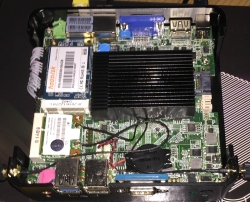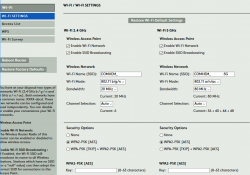Mini-PC for a router
Tuesday, May 23. 2017
In my network setup, it's almost done: we have 1) an Internet-connection, 2) a wireless access-point to pass some mobile device traffic trought it, but something is missing: a router to tie it all together. In my post about my Swedish ISP, it became evident, that running a router they threw at me for free wasn't an option. Second completely viable option would be to run my new Wi-Fi AP with DD-WRT as a router. Totally doable. It has all the suitable ports, DD-WRT is fully equipped to act as an internet router and all that.
Me being a total nerd, of course I wanted to build a real router. The suitable hardware for it would be something tiny having enough ports and packing suitable CPU/RAM/SSD to run a real Linux in it. So, my choice for this is:
Qotom Barebone Mini PC Linux Ubuntu Wintel Nano ITX Celeron j1800/1900 Mini Computer Desktop PC Fanless x86 pc Industrial PC Computer. The marketing people at Qotom chose an appropriate name for their product, huh! ![]() If I'd choose the name, I'd go anthing with less than 19 words, removed "Ubuntu", "Wintel", double "mini", double "PC" and then start cutting the words into something like: Barebone Fanless Mini ITX PC j1800/1900, or so. But that's only me.
If I'd choose the name, I'd go anthing with less than 19 words, removed "Ubuntu", "Wintel", double "mini", double "PC" and then start cutting the words into something like: Barebone Fanless Mini ITX PC j1800/1900, or so. But that's only me.
So, at Aliexpress.com it looks like this:
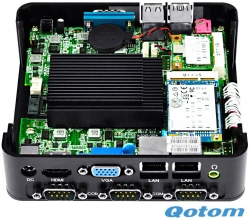
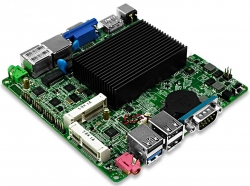
As said, the form-factor is mini-ITX making it a tiny box on the desk. In real life, it looks the same than above marketing material (sorry, pics aren't too good, no DSLR available):
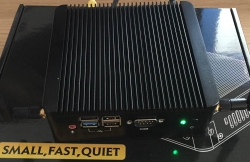
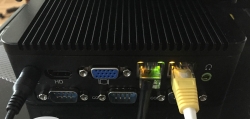
I have no idea who would need 3 x D9 RS-232 -ports, but there they are. My own spec was only to have at least two RJ-45 for Ethernet. This puppy has them with 1Gbit/s speed, adding HDMI and USB-3 on top of that, which are really handy.
As you can see, there isn't much space around the 17x17 cm mini-ITX -board. The biggest one in the pic is the black cooling block on top of Celeron® J1900 CPU. Close up from the internals:
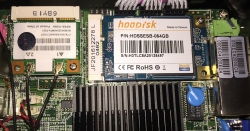
From left to right:
- Broadcom BCM943224HMP Wi-Fi adapter
- 64 GiB Hoodisk mSATA SSD
- Realtek RTL8168evl dual Ethernet connectors
There is some airspace for cooling inside the box:

For PSU there is an external transformer pushing in 12 VDC at 3 amps:
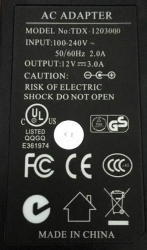
There is a commonly used IEC C13 on the other end of the transformer to make it easier to plug the thing into your country's choice of wallsocket.
I've been running the box for almost a month now, and I'm very pleased with it. The green power-on LED is way too bright. On a dark room, it illuminates everything with green, but other than that I got the perfect box for a router. As these low-budget boxes are easily available, it's mostly about choosing the most suitable one. Apart from having more than one Ethernet RJ-45, one of my selection criteria for this one was, that the manufacturer didn't take any second guesses about the CPU-cooling. It's easily the biggest block I could find among the competition. On top of that, the manufacturer did deliver the unit from UK-storage quite rapidly. What I missed from seller's page was the fact, that deliveries were made from tax-free -zone. I had to pay Swedish VAT for DHL on top of the purchase price.
New toys: iPhone 7
Monday, May 22. 2017
My employer was kind enough to issue me new toys. Any proper nerd loves new toys, I know I do!
So, I got an upgrade for my old(ish) iPhone 6. To a rather big surprise, they're exactly the same thing. Here is a quiz for you iPhone-fans. Tell me which one is 6 and which one is 7:
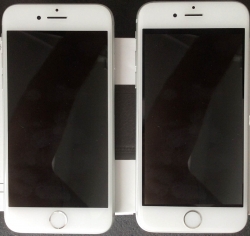



For the first three pics, I honestly don't know which one is which. The fourth one is an easy one, in iPhone 6 there is a white line right below the camera lens, also the lens is bigger on 7. Fifth one is a no-brainer, no 3.5 mm headphone jack exists in the new one.
Other than the missing jack, there isn't much to tell. Upgrade is almost a no-upgrade. Everything is the same, except I had to spend couple hours of restoring the backup. Actually, there was a quirk, my new phone had latest iOS, but the un-boxed one didn't, so I first had to go through the out-of-box-experience and then upgrade it to latest firmware. Then it was possible to do the restore and after restore the thing could start installing my apps.
List of things that didn't transfer:
- Touch ID fingerprints
- Apple support HT204136 says that it should, but ...
- Apps from my employer's app store
- Keyboard dictionary
- Ringtone selections
- I have a dozen or so own-made ringtones for incoming callers.
- The ringtones did transfer ok, but the selection of which one is used didn't survive the transfer.
- Google Authenticator keys
- Read the article "Is there an easy way to transfer Google Authenticator codes to a new device?" for reasoning.
- ... maybe something else I forgot to mention here
Ultimately I have to say, this wasn't worth it. I got the same phone without headphone jack, and I had to spend couple hours of work to get a 32 GiB thing to the point I started with a 64 GiB one. It's a shame there is no 64 GiB iPhone 7. They didn't let me get the 128 GiB, because it's too expensive. The new A10 CPU should be more energy efficient, but in reality it doesn't show. Only after upgrading to iOS 10.3.2, there was some improvement on battery usage. Before that, I had to charge the phone more often that my old one.
The only positive thing is, that now I have a fresh battery to my iPhone. I guess I should find some positive things with the new and improved "best ever" camera, but I simply cannot.
DocuSign hacked: E-mail addresses leaked
Tuesday, May 16. 2017
In my previous post, I was (not so) politely asking DocuSign to admit e-mail addresses leaking.
Finally, they did! They posted Update 5/16/2017 - Update on Malicious Campaign.
Q: What information was impacted?
A: It was a list of email addresses stored in a separate, non-core system used for service-related announcements.
That is something they should have done a week ago, but I guess we have to settle with that.
Btw. I got my hands on the payload VB:Trojan.VBS.Downloader.ACR as named by F-Secure. As many have reported before, it's a MS Word document with a macro in it. The VBA-thingie de-obfuscates a "picture" embedded into the .doc and injects that directly to memory to be executed. I really didn't want to waste the ton of time investigating the actual malware, its bad, I know that without looking. Its just another reminder of how dangerous the VBA-macros are, they can call any system call from Windows kernel and do really complex hacks, like any real executeable would do.
DocuSign hacked: Officially any data leakage is denied
Sunday, May 14. 2017
On 9th and 10th of May I got really weird spam from alleging to originate from DocuSign. The attempt to lure me to hit the link was lame and I didn't believe the communication to be valid at any point. There was no DKIM-signature in the e-mail headers. I know for a fact, that real DocuSign e-mail has that in them. So, any quick analysis of the mail originating from USA and Canada was yelling SPAM! instantly.
The subject of the two first ones was "Completed: Wire Transfer Instructions for docusign Document Ready for Signature" and the third one "subpoena from WEX inc". All of them attempted to get be to download a file from an already shut down websites. All three domains used were 12 characters long .ru-domains and looked random strings to me. I don't know if the words had actual meaning, they just looked random to me. The URLs had my e-mail address Base64-encoded to allow the perps to track any incoming clicks for active e-mails.
Of course plenty of others got the same junk as me, there is a support thread at DocuSign's site: Strange email from Docusign - is it legit? In an answer to that one, the official statement says: "However, DocuSign’s core platform has not been hacked, and our customer data remains secure". In that comment thread there are other people, who don't believe that. I'm one of them.
Why would I make such a bold claim? Well... easy. The e-mail address I'm using in DocuSign is unique. I'm not using that specific address ANYWHERE else. So, people of DocuSign, explain me where the address leaked if not from your system! I guess they claim, that it leaked from one of my systems. But then again, the same thing must have happened for number of other people too. Also, I use hundreds of different addresses for this purpose, to reliably determine which system leaked my information. Any even remotely regular user has their joe.user@mail.com-address registered to dozens and dozens of systems, so they have no possible way of knowing who leaked the data, I do.
I'm urging DocuSign to step forward with a truthful statement about the breach. Their current lies I'm not bying.
Update 15th May:
DocuSign got hacked also two years ago. Same thing happened, they deny any data leakage. Without proof, I feel like throwing unfounded wild allegation here: they have been compromised for over two years now.
In the support discussion thread couple of other people complaining about same thing than I do: the e-mail address isn't being used by anything else than DocuSign, still they're receiving junk to that particular address. How come?
Mirado Tech Talks - HTTP/2, the good, the bad and what's next
Tuesday, May 9. 2017
Mirado Consulting was kind enough to host a meetup, with appropriate food & drinks. By that I don't mean the pencil company:

... but a software development consulting agency in Stockholm.
They summoned Mr. Curl, aka. Daniel Stenberg:

... there to talk about HTTP/2 and QUIC, major improvements on HTTP-protocol. His work with network protocols at Mozilla, as author of libcurl/curl and as member of IETF's HTTPbis work group gives a pretty good picture what's happening at the HTTP-scene today. His presentation was titled HTTP/2, the good, the bad and what's next. In that he covered shortcomings of HTTP/1.1, benefits and shortcomings of HTTP/2 and a very likely future of moving away from TCP-based transport protocol into UDP-based QUIC.
Two tidbits from his presentation:
- Current browser implementations use HTTP/2 only with HTTPS:
- "most client implementations (Firefox, Chrome, Safari, Opera, IE, Edge) have stated that they will only support HTTP/2 over TLS, which makes encryption de facto mandatory", Wikipedia
- "Most existing servers only speak HTTP/2 over TLS", Daniel's blog
- HTTP/2 performance is poor on flaky network
- at 2% packet loss HTTP/2 is at least twice as slow then HTTP/1.1, HTTP/2: What no one is telling you (slide 53) by Hooman Beheshti, VP Technology at Fastly
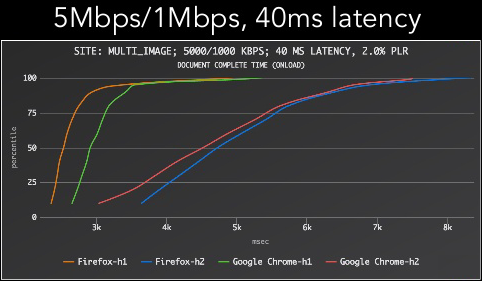
- at 2% packet loss HTTP/2 is at least twice as slow then HTTP/1.1, HTTP/2: What no one is telling you (slide 53) by Hooman Beheshti, VP Technology at Fastly
So, it looks like HTTP/2 isn't going to save us from performance bottlenecks of HTTP/1.1 after all. Hence, QUIC.
About CA certificate handling on a Linux system
Finally, as I've written number of posts about TLS/SSL/HTTPS and one of them was about curl's really clumsy way of handling own CA-certificates. Also, I've always hated the fact, that if I'm running Firefox and curl on a Linux and want to add my own CA-root cert there, I need to do that three times:
- OpenSSL for the everything else in system
- curl for libcurl -depending apps to have it
- Firefox
IMHO that's two times too many! On a macOS you do that only once to the keychain and even curl will use that (yes, I confirmed from the man himself).
The reason is Mozilla's policy. NSS, or Network Security Services, a library written by Mozilla is boasting their FIPS 140 Validation and NISCC testing success, which a plain PEM-file in OpenSSL won't provide. That's why they insist on using NSS as storage and making us regular users suffer the pain of having multiple sources of truth.
Finally
Thank you Mirado Consulting for hosting a great event and Daniel for a great presentation!
Wi-Fi access point - TRENDnet TEW-818DRU - Part 2: Software
Monday, May 8. 2017
In my previous post, I un-boxed my new Wi-Fi access point. This is the part for running something in it.
For this to happen, the obvious prerequisite is DD-WRT binary image built specifically for TEW-818DRU. DD-WRT supported devices -list doesn't say much. Little bit of poking around results in build 23720 back in the 2014 for this one. It is at: https://www.dd-wrt.com/site/support/other-downloads?path=betas%2F2014%2F03-13-2014-r23720%2Ftrendnet-818DRU%2F. As I wanted something newer, I went for November 2016 build 30880 at: ftp://ftp.dd-wrt.com/betas/2016/11-14-2016-r30880/trendnet-818DRU/.
My typical approach for flashing new firmware is to stay connected with a wire. In practice that means, that I'll hook up an ethernet cable to my laptop and the other end to the access point's LAN-switch. Then I'll configure a static IP-address at the laptop's operating system. This makes sure, that I'm 100% connected whenever the box is running. Doing this over wireless connection and/or using dynamicly assigned IP-address may or may not work. As these boxes are expensive enough, I didn't push my luck. The downside of this approach is, that I'll need to know what the actual management IP-address will be.
Ok, let's start!
On out-of-box-experience the web GUI is at 192.168.10.1:
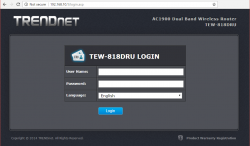
After login, there is a nice setup-wizard. Which of course, we'll just skip by acknowleding the alert:
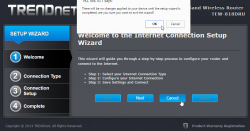
Now we're at the normal administrator environment:
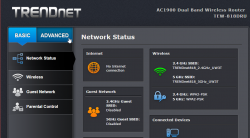
For me, the word "advanced" is like honey to a grizzly bear ![]() . I'll always home towards it, I know that all the goodies are stored there:
. I'll always home towards it, I know that all the goodies are stored there:
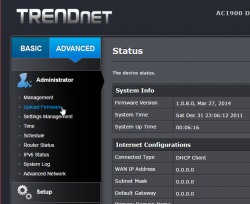
And also this time I was right, firmware upload/upgrade has its own menu item. Its clear, that this device is 100% designed by engineers, they cannot even seem to be able to agree on a single terminology. Menu has "upload", page title has "upgrade". Any self-respecting user experience designer would yell "You're confusing the user with that!", but I guess this stuff is for nerds only, and they don't care.
After selecting the trendnet-818dru-webflash.bin file to be uploaded, there is yet again a nice warning:
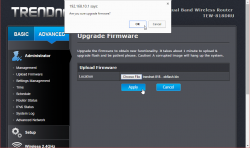
It will take couple minutes for the flashing to complete:
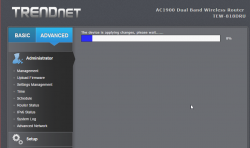
There is very little indication, that the process completed. I didn't notice any lights blinking or something like that. It just completed, rebooted and stayed silent.
Now the IP-addess will change. DD-WRT is 192.168.1.1 at out-of-box-experience:
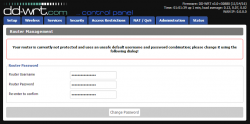
And that's pretty much it for firmware upgrade. At this point I did my wireless access point -setup including:
- Admin username and password
- AP's LAN IP-address, my LAN isnt' at 192.168.1/24
- Enable SSH-service
- Enable GUI-access for HTTPS and SSH
- Wireless network setup for 2.4 GHz and 5 GHz, WPA2 Personal with pre-shared key as security
DD-WRT is for knowledgeable administrators, no setup wizards or mumbo-jumbo. Just the settings.
Btw. configuration docs can be found at: https://www.dd-wrt.com/wiki/index.php/Configuration_HOWTOs
Wi-Fi access point - TRENDnet TEW-818DRU - Part 1: Hardware
Sunday, May 7. 2017
As I mentioned in my post about Swedish ISP, that I like to run Linux on my stuff. My weapon of choice for wireless networking has been DD-WRT for many years (I'm not sure how many exactly, 15+ or so). Any appliance I purchase must be supported by that.
I've been running a lot of Linksys in the past, but this time I chose to go with a Taiwanese TRENDnet TEW-818DRU. The spec is huge and it contains really good 802.11 radios, USB3-port, decent CPU and enough RAM to run it all. And finally: The manufacturer is really keen on supporting Linux.
This is what it looks like. It won't win any design awards, as obviously some software engineer designed the plastic case:
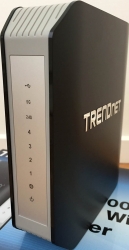
Linux /proc/cpuinfo for Cortex-A17:
model name : ARMv7 Processor rev 0 (v7l)
processor : 0
BogoMIPS : 1594.16
Features : half fastmult edsp tls
CPU implementer : 0x41
CPU architecture: 7
CPU variant : 0x3
CPU part : 0xc09
CPU revision : 0
Memory, physical is 128 MiB, but some is needed for hardware:
total used free shared buffers cached
Mem: 124536 38296 86240 0 4108 12212
-/+ buffers/cache: 21976 102560
- USB3
- USB2
- WPS-button for those who don't care much for security
- 4 x RJ-45 for LAN
- RJ-45 for WAN
- O/I for power
- Barrel connector for 12 VDC, 2 amps power input
It really doesn't get much simpler than that, which is perfect for engineering type persons. Like me! ![]()
You'll get a reliable box with ton on features and possibility of tweaking it to do whatever you need.
In next part I'll put a DD-WRT into it.
Swedish ISP reviewed - Comhem
Saturday, May 6. 2017
It took a lot of time and effort to rent an apartment, Sweden (especially Stockholm are) is notoriously difficult with that. And the first thing any new apartment needs is an Internet-connection. Mobile data in Sweden sucks royally, its expensive and horribly capped with transfer limits. So, something with a wire for me thanks. In this apartment, the options for wired net were highly limited. It's either Comhem or nothing. I chose Comhem.
Back in the 90s, Swedish government subsidied building optical fiber connections to literally every house. They ended up paying roughly 50% of the building costs of proper connections to entire country. Not a bad investment, I have to say. Some businessmen threw rest of the required money and as the result of that, Swedes even today enjoy faster Internet connections than nobody else.
The wall box
Here in Stockholm area this is a very common thing to see:
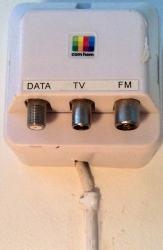
There is something coming into the box from a hole in a wall. I don't know what that could be, possibly fiber, or possibly something with copper in it. If you know, drop a comment! The output is FM-radio, cable-TV and Internet. Radio and TV are regular 75Ω RF-connectors, something you'd generally expect. Data is an F-connector, also very typical for cable-TV Internet connectivity.
The router
Sorry, the pics are really crappy. I don't have my proper camera here in Sweden, so I have to use whatever mobile junk happens to be at hand. The router looks like this:
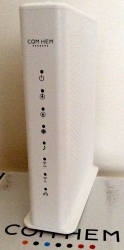
In the back there are your expected set of connectors:

- RJ-11: no idea what this is for, my guess is for a landline phone connection (who needs that!?)
- 4 x RJ-45: Your standard 1 Gbit/s ethernet switch
- Reset pin: do a factory reset with a small pointy thingie
- F-connector: for incoming cable-TV signal
- O/I switch: For on-off needs
- Barrel jack: for 12 VDC power connector, 2,5 amps
- (bonus): 2,4 GHz / 5 GHz Wi-Fi router
Yes, this is one of those French-made Sagemcom boxes. Spec is at: F@ST 3686 AC. Sagemcom is quite big in manufacturing consumer boxes for TV/IPTV/cable internet.
There is nothing special nor surprising there in the router. It's your basic free giveaway box the ISPs throw at you when you sign a subscription. Most people love the fact that this one packs a modern Wi-Fi access point. Personally, I hate integrated crap and want to tinker with my access point more than these integrated things allow me to do.
The admin
As you could expect, there is a web-based GUI admin interface at 192.168.0.1:
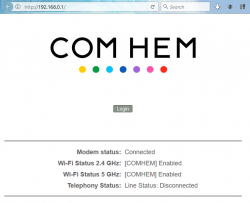
Logging in gives you more details for the router status:
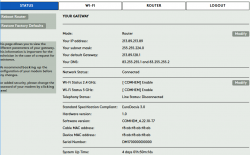
My IP-address, Wi-Fi SSIDs and serial numbers have been redacted, so those of you with evil plans, note that you'll be targeting somebody else.
The speed
I'm subscribing to a Bredband100. The promise is 100 Mbit/s download (actually they say 50-100) and 10 Mbit/s up (range 7-10).
Speedtest, ethernet cable, 1 Gbit/s:
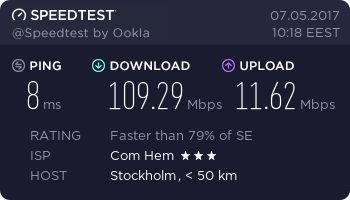
Speedtest, iPhone 6, 802.11ac, 5 GHz:
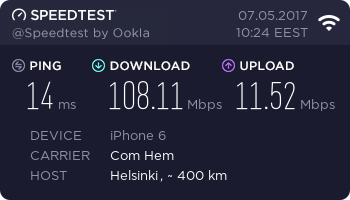
Speedtest, Asus Nexus 7, 802.11n, 2.4 GHz:
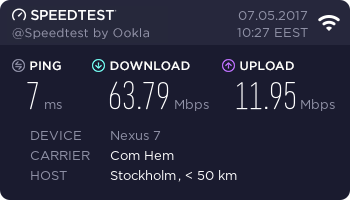
Not bad! They keep the promise. ![]()
If you stumble on the Wi-Fi specs, check the article about Wireless N & Wireless G @ Flashrouters blog about those.
The nominal speed of 802.11n is much higher than 63 Mbit/s, but 2.4 GHz is always very saturated. I haven't counted how many wireless access points are visible here to my apartment, but its easily 50+. Also the throughput of a 2.4 GHz Wi-Fi will drop, if any of my neighbours are using a microwave. Cisco claims, that microwave oven interference can reach 25 feet / 7.5 meters, see the article about that. Unfortunately all my toys will support 5 GHz, so I'll have to run both for the time being.
The result
Generally people love hating big corporations, especially ISPs and telcos. I know I do. A good example of that is: Comhem stumbled on my router delivery as their logistics partner started bouncing the shipment back and forth in the same terminal. Eventually I got the router, plugged it in and it worked. Their customer support is good, I called them at least 4 times to get a subscription and for the delivery issues.
After running this box for a week, I have to say it does the job. On a negative side, the router in router/NAT-mode, the router drops your TCP-connections super fast. This mostly affect SSH and as a remedy I have this in my .ssh/config:
Host *
ServerAliveInterval 25
25 seconds is very fast. Never seen anything like that before. My obvious plan is not disable the wireless AP and switch this baby into a bridge mode and build a real Linux-router to do the NAT. But I'll have to post about that someday.
Ultimately I'm quite happy with this ISP and the router they provided. Out-of-the box it works enough for all people, but provides enough flexibility for me to do some advanced network stuff.
